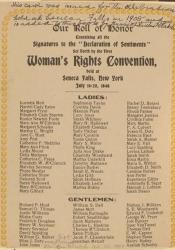Seneca Falls Convention
The Seneca Falls Convention of 1848 was the first women’s rights convention which sought to discuss the “social, civil, and religious condition of woman” (“Report of the Woman’s…” 3). This two-day convention, held in Seneca Falls, New York, on July 19 - 20th attracted many women and men in attendance. The Convention put into question the perception of women, their social status, and their freedoms (McMillen 3-4). The Convention brought awareness to women’s right to vote, to “serve on juries, hold public office, claim their own possessions, earn equal wages, acquire good educations, have access to divorce…” and many other vital topics (McMillen 71). This two-day event hosted six different sessions which included discussion about law, various discussion’s about women’s role in society, and a humorous act.
Two notable women that helped contribute to this movement were Lucretia Coffin Mott and Elizabeth Cady Stanton.
A principle organizer of the Seneca Falls Convention was Lucretia Coffin Mott, a Quaker minister. Her childhood was more unusual than not for the time period as she attended a coed boarding school along with her brothers and sisters. This means, she received an education equal to that of her brother’s. Beside her faith, which preached human equality, Mott’s mother instilled the ideal that women can achieve anything they set their mind to. The frequent absence of her father in the home led Mott’s mother to make all the decisions on the household and for their family business. Lucretia Coffin Mott’s profound advocacy for women’s rights stemmed from (McMillen 5).
Another principle organizer was Elizabeth Cady Stanton. Very few would have imagined Elizabeth Cady Stanton as a reformer because of her conservative upbringing. She grew up in a rural setting where her family held onto traditional values. As society moved advanced (i.e. industrialization), or societal values began to shift (i.e. families having fewer children) the Stanton family seemed to stay back to their traditional ways of life. In almost every aspect, her family held onto their own values which were growing out of mainstream fashion due to their Calvinist belief in predestination. Stanton’s need for female reform stemmed from her own early tensions of wanting to grow but respecting institutionalized authority (Wellman 18). Stanton was a vital figure in creating the “Declaration of Rights and Sentiments” for the Seneca Falls Convention.
The “Declaration of Rights and Sentiments” is a really important document which was read on the first day of the convention. Read by Elizabeth Cady Stanton, for the first time did this declaration give women a voice in such a large public gathering. The Declaration highlights injustices that women experienced and propose resolutions to address these wrongdoings; for example, women were deprived of property rights or women couldn’t attend higher education. This was mainly addressed to male politicians, as they were the only ones who had any influence, to legitimize women’s position in society through law. Moreover, this speech shed not only the light to injustices, but to highlight that this was wrong. Women deserved better than these misogynistic values and they should fight for equal ground. This was an empowering shift towards women and their own perspective about their status in society. This document mimicked the Declaration of Independence as it begins with “We hold these truths to be self-evident: That all men and women are created equal.” The intent of this quote was to find a new meaning behind this statement, to take it quite literally and fight for women’s political and economic equality. It challenged society’s assumptions about female inferiority and their reliance on men. This document was signed by 32 men and 68 women- 100 of the 300 attendees (“First Conventions Ever…” 4-6).
The decade after the convention was crucial since it sparked women’s activism. Women held countless of meeting to address the injustices they faced. They discussed resolutions and persuaded worthiness of their cause. Many committees were formed to study relevant issues, record findings, and most importantly, grow confidence as women took charge. More and more women began to find their voice through petitions, conducting campaigns, writing letters and essays. The Seneca Falls Conventions fostered these activities, but reformers still had a long time to go until their work was made accessible to all women (McMillen 104).
Bibliography
“First Convention Ever Called to Discuss the Civil and Political Rights of Women, Seneca Falls, New York, July 19, 20, 1848.” New York Heritage Digital Collections, Library of Congress, https://cdm16694.contentdm.oclc.org/digital/collection/p16694coll52/id/624
McMillen, Sally. Seneca Falls and the Origins of the Women's Rights Movement, Oxford University Press USA - OSO, 1999. ProQuest Ebook Central, https://ebookcentral.proquest.com/lib/depaul/detail.action?docID=415754.
https://pbs.twimg.com/media/CKXzBSKWwAEzQT8.jpg
“Report of the Woman's Rights Convention, Held at Seneca Falls, N.Y., July 19th and 20th, 1848.” New York Heritage Digital Collections, North Star Office, https://cdm16694.contentdm.oclc.org/digital/collection/p16694coll96/id/63
Wellman, Judith. The Road to Seneca Falls : Elizabeth Cady Stanton and the First Woman's Rights Convention, University of Illinois Press, 2004. ProQuest Ebook Central, https://ebookcentral.proquest.com/lib/depaul/detail.action?docID=3414013.

